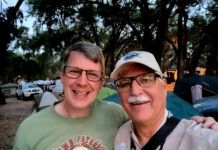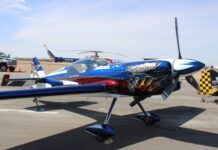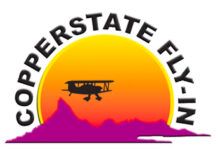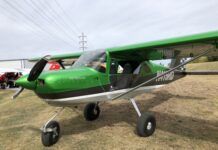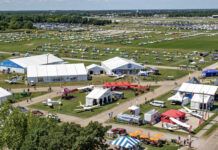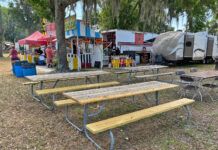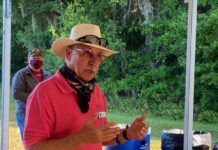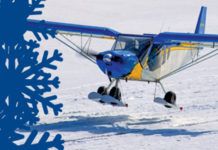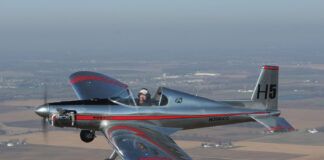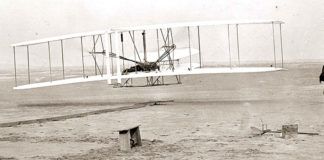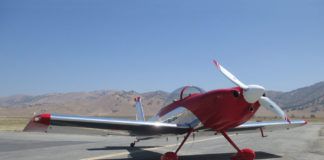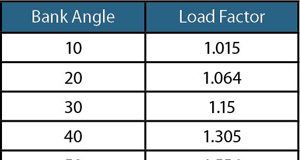I’ve been coming to the EAA convention in for almost 30 years, and it has long been my dream to wing walk. Finally, after years of wondering if the ram air being forced up my nose would cause me to suffocate, I can report that it is not a problem—at least not at the speeds I was flying.
But let’s start at the beginning. In 1979, my then boyfriend and now husband, Barnaby Wainfan, convinced a wonderful gentleman to give me a ride in a Breezy, which looks like a cross between a Mitchell Wing and a jungle gym. Despite my concern that my long blond braid would get caught in the propeller 2 feet behind me, I enjoyed the flight tremendously. There’s nothing like Wisconsin flies splatting on your goggles to give you a feel for true EAA flying.
 That flight convinced me that standing on top of an airplane rather than sitting on it, with the flies coming at me even faster would be exceptionally fun. In 1993, we were building Barnaby’s design, the Facetmobile, in California at the Chino Airport (motto: more cows than Wisconsin and more BS than Oshkosh). In the hangars behind us were not one but six Stearman biplanes, many of them with wing-walking rigs. I inquired as to the possibility of finding standing room over the wing and was informed that due to liability issues, it would be very difficult for me to walk on a wing in California. Bummer.
That flight convinced me that standing on top of an airplane rather than sitting on it, with the flies coming at me even faster would be exceptionally fun. In 1993, we were building Barnaby’s design, the Facetmobile, in California at the Chino Airport (motto: more cows than Wisconsin and more BS than Oshkosh). In the hangars behind us were not one but six Stearman biplanes, many of them with wing-walking rigs. I inquired as to the possibility of finding standing room over the wing and was informed that due to liability issues, it would be very difficult for me to walk on a wing in California. Bummer.
I followed several other leads: the first was a picture in a ladies’ room of an ultralight with a wing walking rig; this was followed by several conversations with the country’s leading aerobatic pilots, some of whom said they’d seen a Stearman with a wing-walker in place make an inverted about 6 inches too low. I also had a long correspondence with a curator of the Smithsonian who sent me a wonderful article about wing-walking. None of these contacts discouraged my desire or provided a clear cut path to the top of a wing.
So here I am at Oshkosh, with about a million people, and I see my chance. I’ve developed a new approach, kind of a pick-up line if you will: “Hi. I’m a rocket scientist and I’m doing research on the aerodynamics of nasal inlets. How about giving me a lift?”
 Well, it worked. I passed a very expensive camera to my 10-year-old daughter Julie and literally told her to take her best shot. The pilot, Steve Hay, showed me where to put my feet so as to not damage anything on me or the aircraft. I buckled in to an ancient leather belt attached to a rusting post—Steve reassured me that “although the belt appeared old and weathered, it had securely held many a wing-walker in its day,” and it would hold me also. Then with the engine running and smoke spewing forth we were off. I now realize that I am the center of attention and an important item in an ongoing show.
Well, it worked. I passed a very expensive camera to my 10-year-old daughter Julie and literally told her to take her best shot. The pilot, Steve Hay, showed me where to put my feet so as to not damage anything on me or the aircraft. I buckled in to an ancient leather belt attached to a rusting post—Steve reassured me that “although the belt appeared old and weathered, it had securely held many a wing-walker in its day,” and it would hold me also. Then with the engine running and smoke spewing forth we were off. I now realize that I am the center of attention and an important item in an ongoing show.
I consciously tried to release my grip on the rear support and attempt a friendly smile. Having succeeded at that attempt, I relax somewhat and remember the queenly wave I’d learned from being in three Rose Bowl parades: to avoid wrist fatigue, rotate your hand as if you’re screwing in a light bulb. This was beginning to be a fun fulfillment of a childhood dream.
 So we’re off, but not yet airborne. We are taxiing and I am gripping, and screwing a light bulb, and Julie takes what I think is a particularly unflattering picture. At this point I’m having a ball, but I remember my concern about the ram air pressure up my nose. I yell down to Steve, but he can’t hear me over the noise of the engine. As we accelerate across the ramp, I figure it’s best not to worry too much; if I’m going to die, I might as well not die all clenched up.
So we’re off, but not yet airborne. We are taxiing and I am gripping, and screwing a light bulb, and Julie takes what I think is a particularly unflattering picture. At this point I’m having a ball, but I remember my concern about the ram air pressure up my nose. I yell down to Steve, but he can’t hear me over the noise of the engine. As we accelerate across the ramp, I figure it’s best not to worry too much; if I’m going to die, I might as well not die all clenched up.
Fortunately, we don’t get going that fast and I am reminded of my wedding day. I’d been looking forward to it for years, it was very enjoyable, and before I know it, it was over. Steve was helpful, actually grabbing my feet and guiding them down every step of the way. The flight service was better than any FBO I’ve ever visited.
Oh, I guess I should mention the type of aircraft I walked on. It’s not so much an aircraft as an ornithopter (from the Latin word meaning “acme flapping bird”). Its performance characteristics are less than stellar: top speed 5 knots, max altitude 0 feet above ground level, and I haven’t had more fun in a flying machine since I flew the DC-3. But that’s another story.

